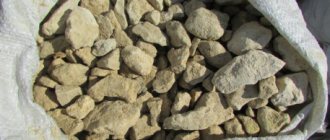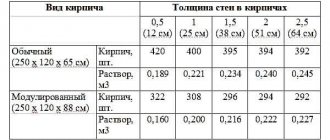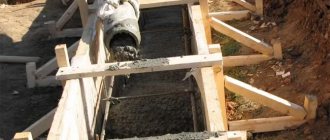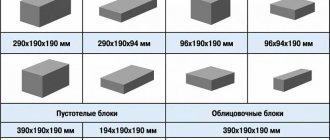During construction work, it is important to calculate in advance how much concrete will be needed, because both shortage and excess mean financial losses. If we know how many cubes in a concrete mixer are delivered in one trip, then we can accurately calculate the total amount of concrete received from the supplier. Let's consider different types of concrete mixers, features of the device and methods for determining the amount of cement mortar that is placed in them.
Concrete mixer for home Source mot16.ru
How do concrete mixers work?
These devices are designed to mix and deliver liquid solution to clients. They contain the following structural elements:
- A drum containing a liquid solution. The power of the concrete mixer depends on the size and type of container.
- The bed is the basis of the structure. All other nodes are located on it. The frame consists of pipes and profiles. Some brands of concrete mixers have a chassis for ease of use.
- Parts used to mix the solution. Blades or augers can be used for this purpose.
- The engine and transmission that rotate the mixer. It can be gasoline or electric.
- A control unit is used to turn on, turn off or change the rotation speed of the concrete mixer.
These nodes are present in all such devices.
Preparation of the solution Source www.rmnt.ru
Proportions of components and operating procedure
It seems that the components have been sorted out. Now it’s time for their number. That is, we will find out what rules and proportions must be observed to prepare concrete for one purpose or another.
First, I will say (or remind you) that concrete is divided into grades based on strength. And each type of strength is used for specific purposes.
The average proportions of concrete in parts look like this: 1:3:5. This means that for 1 part of cement there are 3 parts of sand and 5 parts of crushed stone. Practical builders say that it is more reliable to use the formula 1:2:4.
The proportions of substances for the foundation consist of the following ratio: 8 parts OPGS, 1 part Portland cement, 0.5 parts water. By the way, you can measure proportions in shovels or buckets.
Please note that at one time in a concrete mixer you can mix a solution with a volume of 2/3 of the total size of the tank:
- In a 160 liter concrete mixer you can make 120 liters of solution at a time.
- For a concrete mixer of 180 liters, you need to calculate the number of components so that the total volume does not exceed 140 liters.
If you count in buckets, then for 1 batch in concrete containers with a volume of 150-180 liters you need to put 1 bucket of cement, 2 buckets of sand, 4 buckets of gravel and half a bucket of water.
To avoid overdoing it with water, do a test batch. Do not pour all the water at once. Pour in 2/3 of the intended volume and then gradually add as needed. This way you can choose the optimal quantity.
If you have read the instructions for mixers, then you know that it describes the operating procedure and the sequence of laying out the components. Don't ignore this point, it's really very important.
In general, before starting work, if the machine is completely new or has been idle for a long time, carry out preparations. Check the lubrication on the mechanical elements, turn the mechanism at idle, make sure there are no extraneous sounds.
The loading order itself looks like this:
Wait 1-2 minutes between loading components.
Classification
Concrete mixers can have different designs. They are classified according to several criteria.
By mixing method
In gravity mixers, the internal screw is stationary, and the container with the solution rotates. Under the influence of gravity, the solution falls from the walls, gradually mixing. By changing the inclination of the tank, you can increase or decrease it, controlling the intensity of work.
These concrete mixers can use various mixing methods:
- Inside the drum there is a gear ring located around the entire circumference. A cast iron crown is considered less expensive, but it produces a lot of noise during operation. The plastic crown does not have this drawback. The most expensive option is to use one that is made of steel. In this case, the solution is not protected from the ingress of random debris.
- The gear method is considered the most reliable. Its repair is more complex compared to the coronal one.
Cast iron gear rim Source prom.st
The advantages of this kind of mixers are:
- Due to the fact that relatively little power is required for operation, energy consumption during operation is reduced.
- These models usually have wheels, which makes it easy to move the concrete mixer to the desired location.
However, this type of device has disadvantages:
- The tank needs to be cleaned and washed after each use, which is a labor-intensive procedure. If you do not do this, then gradually a thick layer of dried mortar will be deposited inside, which will complicate work in the future.
- Sometimes the solution splashes out while stirring.
- It is difficult to scoop out the prepared solution, so it is usually first poured from the reservoir into a special trough.
For operation, electric motors are used that require connection to a supply voltage of 380 volts. This is not convenient for all builders.
Preparing for unloading Source veralline.com
Forced action devices include a stationary reservoir and a rotating mixing part. Such devices are convenient in cases where a little water is needed or when using special additives.
Typically, such concrete mixers are large in size, and therefore they are not profitable to use where the volume of work is small.
Such devices are characterized by the following advantages:
- They provide high-quality mixing of the solution.
- Extraction of the prepared solution can be dosed.
In such devices, the following problem can sometimes occur. If the solution is not sufficiently cleaned, it may contain stones or other debris that can jam the rotating part, getting between it and the mixer body.
Forced action concrete mixer Source www.prostanki.com
By continuity of action
Some devices can mix continuously. This helps maintain the quality of the solution for as long as necessary, but requires a lot of energy.
There are concrete mixers that periodically turn off during operation. This reduces energy consumption. Typically, cyclic mixers are used in private construction. When thinking about how to choose a concrete mixer for your home, you need to consider devices of this type.
By type of energy used
A concrete mixer requires energy to perform mixing.
Mixer powered by an electric motor Source domostroi26.ru
It may have the following sources:
- In some cases, a manual drive is used. The work requires significant labor costs. However, such mixers have the advantage of high autonomy. The disadvantage is the small volume of the solution being processed.
- A hydraulic drive can be used. In order to ensure rotation, it is necessary to provide a high-pressure fluid supply. Additional equipment is required during operation. Such mixers are used in industrial settings.
- Some concrete mixers rotate using a pneumatic drive. Since this is ensured by the use of special devices, they are usually used for industrial construction sites.
- If a diesel or gasoline engine is used, this allows you to combine power and autonomy. However, during operation, such mixers make loud noise and produce exhaust fumes. The operation requires purchasing fuel on a large scale.
Powered by a diesel engine Source sc01.alicdn.com
- Electric motors are the most popular. They combine high power and relatively economical consumption of resources. They are used for mixers of various capacities: from 30 to thousands of liters.
Of all of these, electric motors have the most universal application. To know how to choose a concrete mixer, you need to determine which motor is more profitable to use.
See also: Catalog of companies that specialize in equipping foundations and installing stoves and fireplaces.
What volume of mixture can be loaded into a concrete mixer of 100, 150, 180 liters?
A concrete mixer, or more correctly a gravity concrete mixer, mixes the mixture due to the rotation of a metal bulb with blades. Mixing of parts of concrete - water, sand, gravel (crushed stone) and cement - occurs due to the “transfer” of all these components from place to place, due to which their mixing occurs. This will not happen if the concrete mixer bulb stands strictly vertically with its neck up; the contents will simply rotate around its center. The concrete mixer bulb should stand slightly at an angle to allow the blades to lift the solution upward, to one edge, from where it mixes as it falls. Well, if the pear stands at an angle, its useful volume decreases somewhat so that the water does not splash out. Hence, the total volume of a concrete mixer declared by the manufacturer does not mean at all that you will get this amount of concrete in one batch.
For almost all gravity concrete mixers, with the exception of mortar mixers with a horizontal mixing auger, the useful volume of concrete output is about two-thirds of the total volume, or no more than 70%
So, a mixture of cement, sand, water and crushed stone, with a total volume of up to 70 liters, can be loaded into a concrete mixer with a tank capacity of 100 liters. This is the maximum. the ratio of the total volume of the concrete mixer tank and the load, at which high-quality mixing of the components is achieved.
Accordingly, no more than 105 liters of mixture can be loaded into a concrete mixer with a volume of 150 liters, and for a concrete mixer with a volume of 180 liters, this figure will be equal to 126 liters.
Delivery
Concrete mixers are a convenient way to prepare cement mortar. For some chassis-mounted varieties, there is another application: with their help, industrial companies deliver the solution to customers, maintaining it in a liquid state. The width of the Kamaz concrete mixer allows you to deliver a significant amount of mortar in one trip.
Of course, you can make the solution yourself, but you need to spend some time on it and you cannot guarantee the high quality of the concrete obtained in this way.
Concrete is made this way without a concrete mixer Source yandex.net
It is convenient to use the services of specialized companies that will not only prepare the cement mixture of the required brand, but also deliver the liquid mixture, ready for use, directly to the construction site.
Receiving such services has its positive aspects:
- The supply of solution for preparing concrete occurs quickly and efficiently. This is beneficial both for the construction of private houses and for large construction projects.
- With the help of mixers, delivery can occur over long distances without loss of quality.
- When providing services, it is usually provided not only for the unloading of manufactured products, but also for the direct pouring of cement mortar.
This sales method allows the client to order exactly the volume of solution that he needs.
Concrete mix composition
I know that skeptics will say that you can mix concrete just as well with a shovel. Perhaps if you are making flowerpots. Concrete prepared using a mechanized method is 40% stronger than hand-mixed concrete, due to the uniform mixing of substances. In addition, using a concrete mixer, you will not run out of steam, as can happen after the first manual mixing.
Who knows what concrete is made of? I know and will remind those who have forgotten.
The main components are:
- cement (high quality grade not lower than M400);
- sand (cleared of debris and washed of clay);
- crushed stone or ASG (available in different fractions).
A fraction, to put it simply, is the size of stones that fit into certain values (for example, from 20 to 40 mm, etc.) There are fractions for ordinary concrete. These are pebbles with a maximum size of 80 mm. For reinforced concrete structures, mixtures of sand and gravel are used, the size of which should not be more than 30 mm. But for the foundation they take OPGS with a grain size from 5 to 20 mm.
In general, at your request, manufacturers can make absolutely any size of crushed stone and sell it to you at a reasonable price.
All components of the building mixture have special requirements. You can’t just take and mix a solution; you must first make sure the quality of each component:
- Portland cement must be fresh, made recently. Do not give in to persuasion and discounts. Most likely, they want to sell you a product with an expiration date. This is very, very unprofitable. You will buy cheap, but the quality will suffer. You may even have to redo everything. By the way, you can prepare concrete only with M400-M500 cement.
- Sand comes in different varieties. For each type of concrete, different fractions are chosen. Do not buy sand with debris and lumps of clay. You cannot mix the solution with such sand. Either you will have to wash it yourself or you can throw all the concrete down the drain. The size of the sand grains should be 1.5-5 mm.
- Water is also very important. The solution should be mixed only with clean, odorless water (which indicates some kind of chemical impurities) and debris.
- It is better to immediately buy enriched ASG. I think saving a little money will make you regret it when you start sifting the sand and gravel mixture yourself. Besides the fact that it will take a long time, you will be very tired. By the way, one 10-liter bucket with ASG weighs 15 kg. When I was 17 years old, I experienced all the “delights” of enriching PGS through a metal lattice in a frame that my father made himself. But this is my subjective opinion. You decide.
Here's another thing that's important. Various substances can be added to the mixture to improve the quality of concrete or make it easier to lay. There is a huge variety of them. Let's divide them into main groups, and you decide which one suits you best. So, the additives:
- Plasticizing. They make the solution fluid and pliable for pouring.
- Water repellent. They improve the quality of the finished structure in 3 areas: strength, frost resistance, and resistance to the destructive effects of water.
- Modifying. Such additives can increase the setting time of the mixture or, on the contrary, slow it down. This can help beginners pour the solution better.
- Mineral reinforcing. They increase the strength of structures and reduce shrinkage cracking.
Each type of additive must come with instructions. Read it in advance. For example, it is correct to pour some substances only after water, while others are allowed to be mixed into the finished mixture.
Do you use concrete additives?
Selecting a concrete mixer
The following are some tips on how to choose a concrete mixer for your home and garden:
- It is necessary to determine what volume the drum should have: up to 100, 100-150, 150-300, more than 300 liters.
- The thickness of the drum walls matters. If the mixer is purchased for private construction, then 2 mm is sufficient for solid walls, and 4 mm for welded seams.
- When determining the required volume, you need to take into account. That optimal performance is achieved not when fully loaded, but when two-thirds full. In this case, the quality of the mixture will be higher.
- For private construction, it is preferable to purchase a device that uses a crown. It is advisable to buy those that use a part made of polymers.
- The device power of 700 W is most suitable for private low-rise construction.
How much concrete can you mix in a concrete mixer in a day? Personal experience
The time has come for me to pour the foundation for the extension. Since the mixer will not be able to drive up to the formwork and will still have to be transported in a wheelbarrow, I decided to mix it in a 180-liter concrete mixer.
Formwork for the foundation Formwork for the foundation
The foundation area is 11 m2, 20 cm thick. 2.15 cubic meters of concrete are needed. According to preliminary calculations, 30-35 batches are needed.
I thought about inviting several people, but in the end we decided to fill it together.
Mixing concrete in a concrete mixer Mixing concrete in a concrete mixer
If everything is well organized, then everything goes quite quickly, the concrete mixer was loaded immediately with shovels, after first measuring how many shovels fit in the bucket, I calculated how many shovels each needed sand and crushed stone for mixing. This eliminated unnecessary operations (loading a bucket and pouring it into a concrete mixer).
They placed a barrel nearby and filled it with a hose. It is more convenient to scoop from a barrel with a bucket than to fill each bucket from a hose.
Pouring the foundation Pouring the foundation
As a result, the two of us poured 2.15 cubic meters of concrete from 8.30 to 14.30. At the same time, we went once for tea and once for lunch.
The mixture was dumped from a concrete mixer directly into a wheelbarrow and driven on it for 20 meters. One batch was taken away in 2 flights.
Foundation for a boiler room Foundation for a boiler room
By the end, of course, we were tired, but if we wanted to, we could have mastered another cube. I don’t think it’s an option anymore, by the evening my hands will reach the ground)
Ideally, of course, there would be three of us working, two on the concrete mixer and one on laying the concrete. It is also worth considering the complexity of laying concrete. If you need to pour a blind area, installation will take more time, and if the entrance to a wheelbarrow is only on one side, then you will need to remove the concrete with a shovel.
Thank you for reading to the end, I hope the article was useful to you.
Rating
If you plan to purchase a mixer for working at home, it makes sense to pay attention to the following rating of concrete mixers, which includes popular and high-quality models:
- RedVerg RD-CM 63
It has a drum volume of 63 liters. It is suitable for building a summer house. This concrete mixer can be purchased at an affordable price. She has a high-quality polymer crown. Disadvantages are loud noise,
- Concrete mixer Lebedyan RN-200
Suitable not only for home use, but also for professional construction work. The drum volume is 200 liters. Immediately after the end of the cement mortar preparation cycle, you can start the next one. A powerful electric motor is used. A batch of solution can be prepared in two minutes.
Concrete mixer Lebedyan Source i1.ytimg.com
- Model SBR-100
Has a cast iron crown. The solution preparation time is one and a half minutes. This concrete mixer operates from a 220 V network. Rotation is transmitted from the motor using a soft belt. If operated in a state of overload, it may wobble greatly.
There are various types of concrete mixers on sale, among which the client can always choose the most suitable one.
Samomes: proven recipes and mixing features
When it is not possible to order a mixer with concrete, or you need to concrete structures of small volumes, self-mixing concrete comes to the rescue. The only question is how to cook it? At first glance, it seems that nothing is simpler. We take the “folk” proportion 1:3:5. That is, for one part cement, three parts sand and five parts crushed stone, add water “to taste.” Let's also pour some detergent into the concrete mixer. After all, everyone does it. And... voila, self-mixed concrete is ready. Do not hurry! Most often this leads to problems. The foundation filled with such self-mixing crumbles the next year. The blind area cracks and the lintels burst. To prevent this from happening, read our article, which contains time-tested recipes for self-mixing concrete.
- Proportions of durable self-mixed concrete
- In what order should you pour the self-mixing ingredients into the concrete mixer?
- How much concrete can a concrete mixer mix at a time?
- Why concrete should be vibrated and not bayoneted
- Is it possible to add household detergents to concrete?
Recipes for filling a concrete mixer
According to the rules, in order to prepare high-quality self-mixed concrete, you need to find the voids and moisture content of the sand and crushed stone that was brought to your site. Calculate the bulk density of cement and the density of cement mortar. Tell me honestly, who will do this on a real construction site? Especially if hired workers are building your house. Exit - print this article and use it as a cheat sheet when making self-mixed concrete.
Self-builder
I want to prepare self-mixing concrete. There is a 132 liter concrete mixer. I want to know the proportions of the concrete mixture for pouring the foundation for one batch, so as not to overload the concrete mixer.
FORUMHOUSE participants answer the question.
I am making a columnar foundation for a bathhouse. Concrete mixer for 130 l. Mixture proportions:
- 2.5 shovels of cement grade M500;
- 6 shovels of sand;
- 8 shovel granite crushed stone of fraction 5-20;
- some water.
When I trimmed the pillars to the level, the concrete was hardly sawed by a powerful grinder with a diamond blade with a diameter of 230 mm.
Briefly about the main thing
There are many types of concrete mixers. Some of them are intended for industrial, others for private construction.
Depending on the device, the tank in which the cement mortar is mixed has its own characteristics that affect its performance.
The actual volume of concrete supplied in automixers may not correspond to that stated in the invoice. Usually, this is the result of an oversight at some stage of loading, so it is best to control the entire process yourself.
You can control the amount of concrete by comparing the weight of the machine before and after loading, measuring the unloading time, plus making sure that the concrete is poured into a clean mixer.
Characteristics of KamAZ 65111
The number of cubes that Kamaz can transport depends on the type of vehicle and its characteristics. Machine 65111 is distinguished by its volume, it is 8 cubic meters, for loading materials in the form of bulk elements. Such a machine is used to remove various types of garbage, for example, after demolishing old buildings, since not every machine is able to withstand the weight and volume of such a load.
Also, the main loads for transportation on such vehicles are construction-type materials and garden structures.
The body element has a volume of about 8 cubic meters, the car can drive even on the most broken roads and potholes, this makes it possible to move cargo to remote areas or villages, as well as dacha cooperatives that do not have ideal road surfaces. The car has a high degree of maneuverability, this helps it take difficult turns without difficulty, as well as turn around on narrow streets. The main advantage of the Kamaz is that it does not destroy the road into the mud, unlike heavy vehicles. Such a vehicle can deliver a large weight of cargo, both solid construction and bulk.
The load-carrying capacity of the 65111 vehicle is about 12 tons, so crushed stone can be loaded up to 8.5 cubic meters, since the material has significant weight.
The most necessary materials for delivery are crushed stone and sand; they are used in the construction of various structures. All of the above vehicles are used to transport such goods.
The calculation of the crushed stone that needs to be transferred depends on the load capacity of the machine
Pay attention to the resulting number when calculating, otherwise it will not be possible to load a full machine due to the significant weight of the material. The sale and loading of all bulk materials is carried out strictly according to the specified standards, taking into account the cargo capacity of the dump truck
Kamaz trucks can have a capacity of 6,8,10 and 12 cubic meters of cargo; if you plan to purchase a large volume of materials, then special vehicles with capacities of up to 25 m3 are used.
What is proper concrete?
A composition that is made in compliance with the requirements of SNiP 82-02-95 is called correct. What factors influence the amount of cement in the solution?
Proper concrete must exactly comply with the requirements of SNiP
Table. Factors influencing the mass fraction of cement in concrete
| Concrete mix requirement | Amount of cement |
| All proportions for types of concrete are given based on the M 400 cement grade. If you use higher quality M 500 cement, then its quantity for the same concrete strength can be reduced (multiplied by a factor of 0.88), and if you use M 300 grade cement, then on the contrary, the quantity increases (multiplies by a factor of 1.13). |
| Fillers | Basic cement consumption rates are given for the production of concrete with crushed stone filler. But this is a rather expensive material and in practice it is often replaced with gravel. In this case, the calculated norm of cement must be multiplied by factors of 0.91–0.98, taking into account the class of concrete in terms of compressive strength. |
Prices for cement and basic mixtures
Cement and base mixtures
What factors influence cement consumption rates?
During the compilation of the tables, the so-called lightweight concrete produced using traditional technology was taken into account; during its laying it is recommended to use vibration mechanisms.
Vibrator for concrete compaction
Cement consumption was differentiated taking into account several factors.
- Purpose of concrete. It is allowed to be used for pouring foundations, floors, for single-layer external and internal insulation of various architectural structures.
- The required class of concrete in terms of strength, density, frost resistance and other performance characteristics.
- Type and brand of cement, hardening time.
Basic cement consumption values for different types of lightweight concrete are given in the tables.
Table of cement consumption rates for concrete on gravel fillers
Table of cement consumption rates for concrete on crushed stone fillers
Table of cement consumption rates for hollow concrete blocks
The tables provide for the use of cement that meets the requirements of GOST 10178. A slight increase in the amount of cement is allowed.
Calculation of cement consumption











